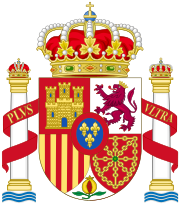Spanish prime-ministerial transition
 |
|---|
The Spanish prime-ministerial transition is a procedure by which the
As a summary, the procedure is as follows: after a general election, the Congress of Deputies nominates a prime minister, who is subsequently appointed by the monarch.
Election
In Spain, the Prime Minister is elected not by the people but for the Congress of Deputies. In the General Election, the different parties present a closed list of candidates to the Congress and people vote for each party and the full list. Normally, each party has his own candidate to premiership, which is normally the leader of the closed list and the party. When the results come out, each party (if it has enough votes) wins seats (escaños) on the Congress in proportion to the number of votes.
Following the general election of the Cortes Generales, and other circumstances provided for in the constitution, the monarch meets with and interviews the leaders of the political parties represented in the Congress of Deputies, and then consults with the President of the Congress of Deputies (who represents the whole of the Cortes Generales and it is elected from within the members of parliament) before nominating his candidate for the premiership, according to Section 99 of Title IV of the Spanish Constitution.[3] Often minor parties form part of a larger major party, and through that membership it can be said that the king fulfills his constitutional mandate of consulting with party representatives with Congressional representation.
Title IV Government and Administration Section 99(1) & (2)
- (1) After each renewal of the Congress and the other cases provided for under the Constitution, the King shall, after consultation with the representatives appointed by the political groups with parliamentary representation, and through the Speaker of the Congress, nominate for the Presidency of the Government.
- (2) The candidate nominated in accordance with the provisions of the foregoing subsection shall submit to the Congress the political program of the Government he or she intends to form and shall seek the confidence of the House.[3]

After the Congress confirmation, the
Presidents
Acting prime minister
The acting prime minister is the head of government that remains in office until the next prime minister is sworn in or the current acting prime minister is re-elected. The acting prime minister does not have to be an outgoing prime minister, however, its powers are limited by the
Outgoing prime minister
The outgoing prime minister not presenting for re-election remains in office in a caretaker capacity until their successor is sworn in. However, his powers are limited because his official term finished the day that he convoked the general election. In this way, many decisions are reserved for an full-capacity prime minister.
An example of this was the 2011 general election, when outgoing president José Luis Rodríguez Zapatero did not run for re-election and he took care of the office until the newly appointed prime minister, Mariano Rajoy, was sworn in.[7][8]
Prime minister–designate
The term "prime minister-elected" is not proper to the parliamentary system because the president is not elected directly by the people but for the Congress. The term can be used unofficial if the biggest party has an absolute majority on the Congress or has the support of other party, which indicates that the candidate, although he has not been directly elected, he will overcome the congressional confirmation (Investidura). The most appropriate it would be "prime minister–designate", because the Congress proposes the king a prime minister.
Powers transition
After the prime minister's confirmation in the Congress, he becomes the official Prime Minister. The powers transition is merely a ceremonial act. The new president normally meets the outgoing president at the Moncloa Palace (prime ministerial palace and headquarters of the government) and after a conversation, they go to the main door in front of the media and the outgoing president gives the president the presidential briefcase as a symbol of a transition of power.[9] The Ministers of the Crown do the same with their respective briefcases.
References
- ^ Official web site of La Moncloa, the Spanish Prime Minister's Office Accessed 2009-03-05
- ^ The Oxford Spanish Dictionary and Grammar, ed. C.Lea et al., 2nd ed.(2001)
- ^ a b Part IV Government and Administration
- ISSN 1134-6582. Retrieved 2023-11-18.
- ISSN 0307-1235. Retrieved 2023-11-18.
- ^ Maestro, Laura Smith-Spark,Laura Perez (2018-06-02). "Pedro Sánchez sworn in as Spain's Prime Minister after ousting Mariano Rajoy". CNN. Retrieved 2023-11-18.
{{cite web}}: CS1 maint: multiple names: authors list (link) - ^ Rajoy y Zapatero se reúnen durante dos horas en la Moncloa
- ^ Acting President Zapatero
- ^ Rajoy y Zapatero comienzan el traspaso de poderes con dos horas de encuentro en Moncloa
